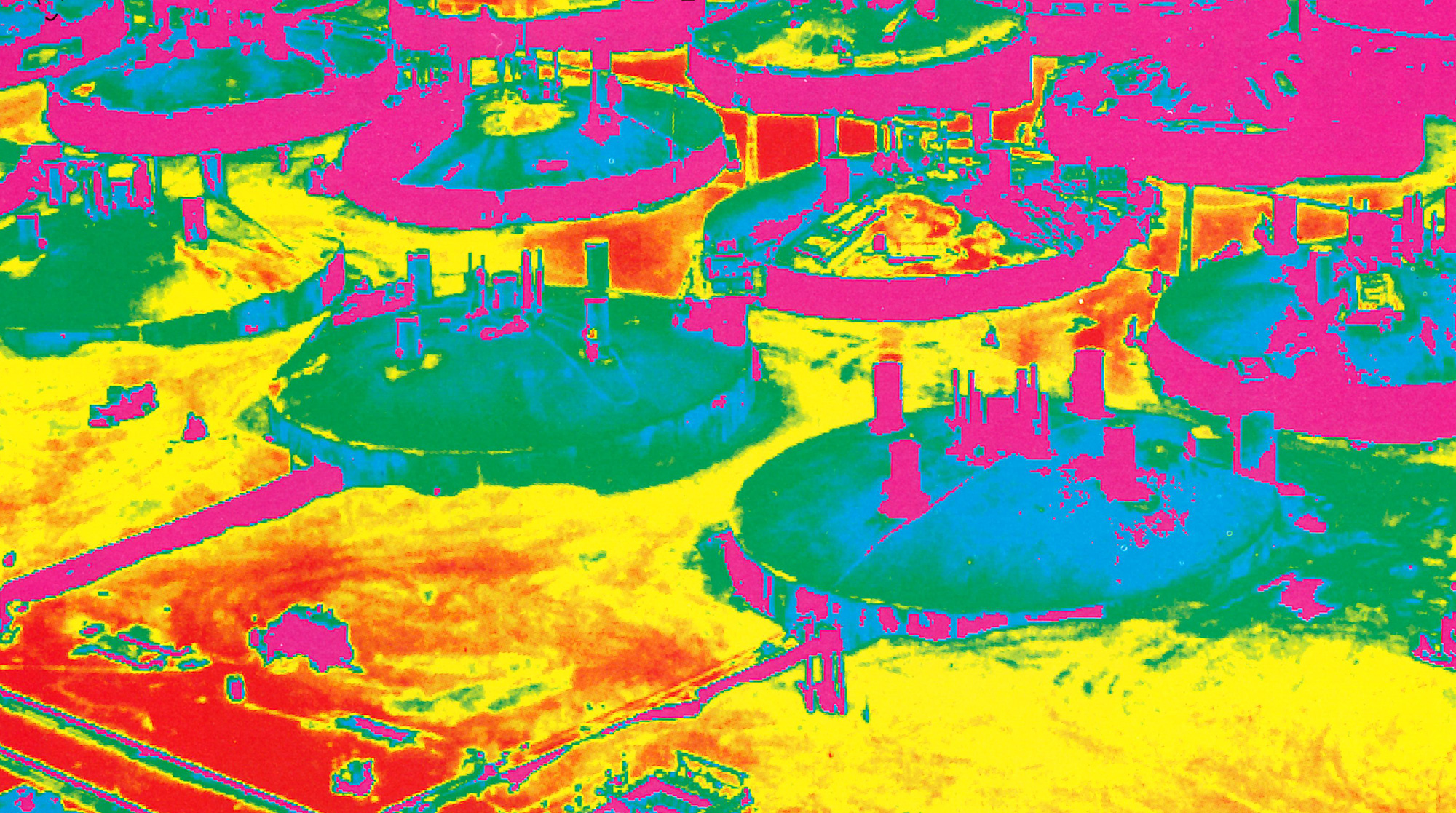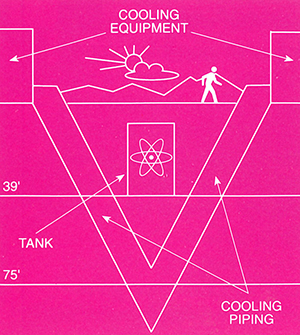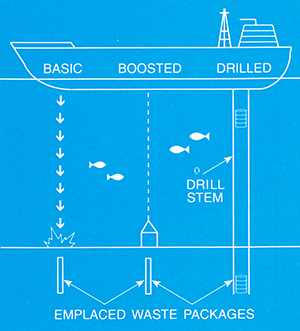

It’s the issue that refuses to go away. After all, how do you sweep 65 million gallons of high-level radioactive waste under the sagebrush of the Hanford Nuclear Reservation? And what do you do with all the debris no one bothered to catalog—the radioactive laboratory animals, the trucks, kitchen sinks and who knows what else—that already has been bulldozed beneath the sands of eastern Washington?
The nuclear waste disposal problem is going to be around for a long time. It’s been around nearly half a century, since we began to make atomic bomb material at Hanford. It’s going to linger far longer because the residues of the bomb makers and the nuclear power industry must be stored safely for perhaps 10,000 years.
The size of this 10-millennia mess is gargantuan. More than 60 percent of the nation’s high-level radioactive waste from weapons production is stored at Hanford. Among the hazards are 149 single-shell holding tanks filled with lethal mixtures of liquid and solid nuclear and chemical waste. Sixty-six tanks have been identified as leaking or possibly leaking, according to the Bulletin of Atomic Scientists.
Elsewhere are trenches and basins dug in the soil where millions of tons of liquid and solid wastes were deposited. Hanford’s PUREX plant, the world’s largest plutonium reprocessing facility, produced an estimated two billion gallons of waste water and cooling water. This amount of water—about double the size of Seattle’s Green Lake—was poured over the desert.
That’s just some of the known hazards. No one knows for sure where other burial sites from the early days of the Manhattan Project are—or what’s in them. Records of this activity never existed or were destroyed in the name of secrecy and national security.
With the wastes we know about, Department of Energy scientists have a “preferred” technology for the 10,000-year problem: Bury it.
They’ve chosen a site about 100 miles northwest of Las Vegas in the Nevada desert called Yucca Mountain. They plan to riddle the mountain with chambers, where nuclear waste will be stored in canisters. And with that decision, the nation has stopped exploring other possible solutions.
“The United States ought to worry about having viable options. To put all our eggs in the Yucca Mountain basket is as unwise as was putting all our eggs in the space shuttle basket before the Challenger disaster and then winding up with no unmanned launchers. We need to have insurance, backups,” contends Edward Miles, director of the UW School of Marine Affairs.
Miles was involved in the abandoned effort to study the ocean floor as a waste site. There are other waste options as well. UW researchers say we can freeze it or vitrify it (burn it into a glasslike material). And some UW experts contend we need to do nothing more than stabilize and monitor the material where it is.
A do-little approach is what we have now by default. In 1983, the Department of Energy proposed a plan to Congress that, among other things, called for:
Both the Carlsbad site and Yucca Mountain have come a cropper. The former was supposed to open in late 1988, but groundwater seepage and other problems repeatedly delayed the project, which already has consumed about $1 billion. Yucca Mountain always has been a controversial choice. New evidence points to relatively young (5,000 to 10,000 years ago) volcanic activity nearby. The mountain is made of volcanic ash and there are questions about how water flows through the material. These obstacles must be answered before the project can proceed.

Frozen Desert: Cooling pipes plunged beneath leaking waste tanks at Hanford could form a frozen, V-shaped barrier, preventing liquid waste from seeping into the ground water. Illustration by Ken Shafer, based on a design from RKK Ltd., Bellevue, Wash.
Alarmed at the scope of the disposal problems and DOE’s slow progress, Washington state pressured the energy department in the early 1980s to meet state and federal environmental regulations. The Environmental Protection Agency joined the push to clean up Hanford. DOE eventually bent under this accumulated pressure and in 1989 agreed to the Tri-Party Agreement, which calls for spending $50 billion over 30 years to fix the worst of Hanford’s problems.
Coming up with any acceptable Hanford solution is complicated because the problem has been fused with the question of what to do with the growing pile of waste from the nuclear power industry.
“These are two very different problems,” explains Physics Professor David Bodansky. “The questions at Hanford stem from a certain sloppiness and doing things too quickly. Its waste is primarily liquid. Nuclear power plant waste is a problem of extreme caution, of not wanting to do something unless it is done precisely and correctly. The distinction between the two has been blended together in public opinion. But there is a big difference in the hazards they present and in the procedures we have used in the past and need in the future.”
So what can and should be done? That depends on who you ask.
Nuclear Engineering Professor Kermit Garlid says the best way to deal with Hanford is to stabilize the waste and leave it on the reservation.
“The first thing that has to be done is to identify what’s in all of the tanks,” he says.
The potential for an explosion isn’t high, although there is at least one with high temperatures that’s burping. The heat in that tank is a combination of radioactive decay and chemical reactions. The risk is from a chemical explosion, not a nuclear one.

Burial at sea: Torpedo-shaped canisters of nuclear waste could be fired into ocean sediment under the “basic., option (left in diagram). For greater penetration, either a “boosted” firing or a drop down a tube (“drilled” option) could be done. Illustration by Ken Shafer, based on a design from Sandia National Laboratories, Albuquerque, N.M.
“Over the years, chemical processes at Hanford changed. They used different chemicals trying to neutralize stored nuclear waste material, but they didn’t store them separately as they were supposed to. This led to a witch’s brew of chemicals that formed sludges and slimes in the tanks and left radioactivity in a very messy form.”
“The chemical problem may be more severe than the radiation problem,” adds Environmental Health Professor Maurice Rabkin, one of three UW faculty members appointed to a Hanford technical steering committee. The panel monitors work for the Centers for Disease Control which is evaluating radiation doses released from Hanford over its 50-year history.
Garlid doesn’t think the wastes pose much of a health risk. “But every time you move or process it, you create another waste stream and usually create more waste than you started with,” he says. “What we should do is monitor the waste and make sure it is as in1mobile as possible. If a tank leaks, freeze or vitrify the leakage.”
To vitrify the leaking waste, engineers would turn the material into glass. For example, says Civil Engineering Professor Robert Holtz, they could plunge electrodes into the ground beneath the tanks, turn up the juice to several thousand degrees, and “bake” the contaminated sands until they turned solid.
Physics Professor Greg Dash is a strong advocate of freezing nuclear waste, as a short- or long-term solution. Two years ago he and a Bellevue technology company proposed building 50- to 75-foot thick underground ice barriers to stop leaking tanks.
“DOE has no idea of the situation inside some of the tanks and they are pouring water inside to cool them off. Almost certainly some of that water is going right through into the ground. I don’t see that we can stop the stuff from continuing to leak, but an ice barrier can buy time. We don’t have the perfect solution today, but if ice barriers are put in place, we’d have the time to do the research and development work in the right way,” says Dash.
Workers would make ice barriers by sinking a series of pipes into the ground at a slant, forming the shape of a canoe’s ribs, to surround a polluted site. They would then pump refrigerant into the pipes, causing groundwater to freeze solid and form thick ice walls in six months to a year. Once the barrier is solid, Dash estimates it would only cost about $19,000 annually to maintain a 10-acre site. A power failure wouldn’t be a disaster because it would take about two years before liquid waste would be able to breach the ice, more than enough time to reestablish the barrier.
Dash, who chairs the company’s technical advisory panel, says the firm has made proposals to DOE to test the barriers at Hanford and three other contaminated sites across the country. The benefits, he says, are numerous. It is the only technology that can get under waste without having to dig up the material. The technology is leakproof, does not corrode, can be repaired in case of cracking or an earthquake by injecting more water into the barrier, and is inexpensive and removable.
This deep-freeze technology is available now, while both Dash and his physics department colleague, David Bodansky, have doubts about underground storage in Yucca Mountain. “We won’t have a national storage repository,” claims Dash. “Yucca Mountain is dead and no state wants one inside its borders.”
“My own preference is for deep geological storage,” adds Bodansky, a proponent of nuclear power. “It is unlikely we will solve our energy problems without the nuclear energy option. But people won’t be convinced nuclear power is safe unless we have a viable waste disposal solution. So it is vital we develop one that is very safe and one that people believe is safe.
“The level of fear and concern about nuclear waste is disproportionate to the hazard. The overall danger from the buildup of greenhouse gases is probably higher. Eventually we will have to use nuclear fuel as a replacement for hydrocarbons, but until a safe disposal solution is found, the fear inhibits finding a solution to a greater problem—global warming.
“But Yucca Mountain shouldn’t be the only geological site evaluated. We need other sites to be explored. That was the original plan, and we need substantial alternatives such as sub-seabed storage.”
This “20,000 Leagues Beneath the Sea” proposal has two UW advocates: Miles of Marine Affairs and G. Ross Heath, dean of the College of Ocean and Fishery Sciences. They participated in international sub-seabed studies that ended in 1986 when the United States opted for land disposal of commercial nuclear waste. Both believe ocean storage is a political long shot, but one that needs to be explored.
“U.S. policy is land disposal, but if a common flaw is found in land repositories or if there is an accident, we need it as insurance,” says Heath. “After 13 years of work, no technical issues had been raised indicating it was unsafe or environmentally hazardous. I was very apprehensive about the idea at first. My instant reaction was to be against it. But point by point I found there is no reason, no problem with sub-seabed storage.”
The plan calls for two international repositories at a depth of three to five miles—one each in the North Pacific and North Atlantic oceans. Torpedo-shaped canisters filled with waste would be fired from the ocean surface into the soft clay of the seabed. The force of the impact would quickly seal the gooey clay behind the canisters which would settle 30 to 70 meters beneath the sea floor. In another scenario, canisters could be lowered to the repository through long tubes. Signaling devices on canisters would permit them to be located and, if necessary, retrieved.
“There are two main advantages to sub-seabed storage over land storage,” explains Heath. “First, individual waste containers can be put 300 feet apart in the mud. The material in them can cool down quickly compared with storage in a mine, where they become a very big thermal mass. We can place canisters very accurately with existing technology.
“More important is long-term safety. With sub-seabed storage there is no reason for people to be there and the odds of nuclear material vanishing are very small. In geological storage you have to assume there could be some human intrusion. Someone will drill a water well or whatever and it is very difficult to imagine no social upheaval in the next 10,000 years.”
Miles estimates it will take between six and eight years to complete research on the concept and another 10 years to conduct a demonstration test. He and Heath concede the likelihood of that happening soon is remote.
As we learned when we were children, it always takes longer to clean up a mess than it does to make it. There is no magic solution or quick fix for Hanford.
There are just a lot of choices to be made and alternatives that must be explored. Eventually, says Environmental Health’s Rabkin, solutions for Hanford will be found.
“In our history, technology has a pretty good track record for solving most of the problems we’ve come up with. The human mind is also conducive to taking advantage of serendipity, but we can’t expect instant gratification for technological problems. First we have to put in the sweat, beat our heads against the wall and finally, after years and years of work, come up with the answers. Someday we’ll have the answers to Hanford. It’s hard to convince people of that.”